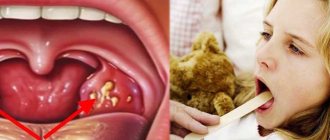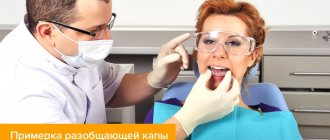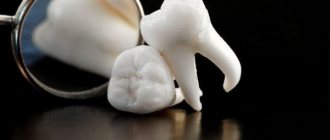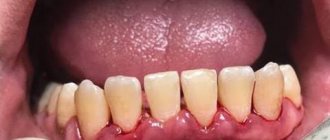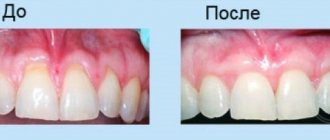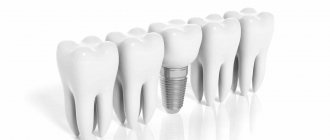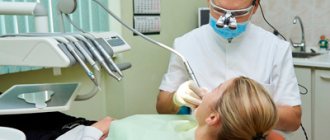Herpetic gingivostomatitis
This form of the disease develops due to the herpes virus type I.
Its symptoms include round ulcers with a white coating, red at the edges, no larger than 0.5 mm in size, covering the mucous membrane of the mouth and gums. Acute gingivostomatitis is characterized by high (up to 38-39 degrees) temperature, bleeding and swollen gums, and inflamed lymph nodes. The number of ulcers sometimes reaches 15-20 pieces. Weakness occurs, problems with eating due to pain, appetite disappears, sleep is disturbed. These symptoms may be accompanied by signs of acute respiratory viral infection or catarrhal tonsillitis.
Other types of gingivostomatitis - allergic, plasmacytic and atypical - are much less common.
Causes of gingivostomatitis
For the development of ulcerative gingivostomatitis, a number of factors are necessary, the main one of which is a decrease in the body’s protective reaction.
The disease usually occurs when one or more of the following factors are present:
— An organism weakened due to illnesses; — Hypothermia, colds: — Chronic infections and diseases; — Inflammatory processes in the mouth, tartar deposits; — Chronic injury to the oral mucosa (for example, due to dentures); — Diseases of the immune system (including HIV); — Lack of vitamins, iron deficiency anemia; — Lack of oral hygiene measures for a long time; - An allergic reaction to toothpaste, medications or any food.
Symptoms
Clinical features of epiglottitis vary depending on the etiology, age, and severity of the disease.
In young children, respiratory distress syndrome is usually diagnosed - a progressive respiratory disorder, manifested by shortness of breath, chest depression during inspiration, cyanosis, pallor of the skin, and wheezing when breathing. To facilitate breathing, the child takes a sitting position with the body tilted forward, the neck is extended, the chin is pushed forward. Drooling may occur.
In older children, adolescents and adults, epiglottitis is more often manifested by a sore throat and drooling. During pharyngoscopy (examination of the pharynx), there is often no hyperemia and swelling - the oropharynx looks healthy.
Epiglottitis in children is characterized by a sharp onset and rapid progression of the disease. As a rule, 12-24 hours pass from the moment of the first signs to hospitalization.
The main symptoms of the disease in children:
- difficulty breathing (80%);
- stridor - noisy, wheezing breathing (80%);
- muffled voice or hoarseness (79%);
- pharyngitis (73%);
- fever (57%);
- sore throat (50%);
- sensitivity of the anterior surface of the neck (38%);
- cough (30%);
- difficulty swallowing (26%);
- voice change (20%).
The main symptoms of the disease in adults:
- sore throat (90-100%);
- fever ≥37.5°C (26-90%);
- muffled voice (50-80%);
- drooling (15-65%);
- stridor (33%);
- hoarseness (20-40%).
Gingivostomatitis in children
Most often in childhood, gingivostomatitis occurs, caused by the herpes virus.
The disease occurs in an acute form, usually of moderate or severe severity. Gingivostomatitis in a child begins with a sharp rise in temperature, lethargy, and headache. All these symptoms in children appear even before ulcers appear in the mouth, and they can easily be confused with signs of a cold or flu: there is a cough, runny nose, and sometimes diarrhea.
Upon examination, enlarged lymph nodes under the jaw and on the neck and reddened gums are detected. For 2-3 days, the oral mucosa becomes covered with ulcers, which are very painful. The illness lasts one to two weeks.
Treatment of gingivostomatitis consists of aseptic treatment and anesthesia of the oral cavity, as well as antiviral therapy and strengthening the immune system.
Complex chronic gingivostomatitis in a cat
G. Camus
To successfully treat gingivostomatitis in cats, it is necessary to bring them to the clinic at least three times within four months. This allows the clinician to take appropriate action as the symptoms of the disease change.
Gingivostomatitis in cats is quite common. The main clinical sign is more or less progressive inflammation localized in one or several regions of the oral cavity. The most severe and painful stages of inflammation lead to the manifestation of functional signs of disorder, which are mainly the reason for seeking a consultation with a veterinarian.
Currently, the multifactorial cause of oral diseases in cats is combined under the name complex chronic gingivostomatitis in cats and is divided into impaired immune processes and the penetration of viral strains (caliciviruses).
Conservative treatment prior to surgical removal of areas susceptible to periodontopathy and odontoclastic resorption is sometimes ineffective. In this case, there is a need to use antibiotics, anti-inflammatory drugs and, more recently, omega-interferon.
The described diseases of the oral cavity, which are difficult to treat and evolve towards a chronic course, are also called “lymphoplasmacytic stomatitis” in connection with the histomorphological picture, which is constantly discovered when examining the material taken for research. Clinically, this manifests itself in the form of gingivitis, periodontitis, orostomatitis, palatoglossitis with the presence of relatively pronounced ulcerative and/or proliferative processes (photos 1, 2).
| Photo 1. Gingivitis and palatoglossitis. | Photo 2. Ulceroproliferative palatoglossitis in a cat positive for FIV and calicivirus. |
Due to the large number of failures during standard (same type) treatment, taking into account the etiopathogenesis, as well as the localization and degree of intensity of the disease, we propose the following therapeutic regimen, which is built in accordance with the etiology and nature of the disease.
The main stages of examination of a patient with gingivostomatitis
First visit General clinical examination:
– detection of FeLV-FIV; – removal of tartar; – selective extraction.
Second visit Repeated examination using the same methods (after two months):
– areas with missing teeth are still susceptible to the inflammatory process: control radiography + extraction of root fragments that may not have been removed; – areas with teeth are still in the stage of the inflammatory process: complete extraction, except for the fangs; – inflammation of the ridges of the palate: detection of calicivirus (treatment with interferon in case of a positive result of a serological test) and gentle cauterization.
Third visit Repeated examination of the oral cavity (two months after the second visit):
– similar re-examination; – interferon in case of persistence of calicivirus; – corticosteroid therapy in the absence of calicivirus.
Gingivostomatitis: general virological examination
Prognostic assessment of the course of a disease such as gingivostomatitis and its outcome by identifying retroviruses (FeLV, FIV) allows us to have the clearest idea of the intensity of lesions associated with FIV and its relapses. It should be noted that this is the main stage, which allows us to predict the effectiveness of treatment (it will be ineffective if a positive reaction to the persistence of the pathogenic agent is detected).
Selective extraction
Identification
Identification of areas of periodontitis and teeth susceptible to odontoclastic resorption (photos 3, 4) is the first step in deciding on a conservative surgical intervention. These two forms of disorders, identified in complex chronic gingivostomatitis, which can accompany this pathology and complicate its course, must be treated first. Surgical treatment of these areas, based on their removal, is called the selective extraction stage.
| Photo 3. Violation of odontoclastic resorption (damage in the neck of the tooth). | Photo 4. Severe periodontitis. |
Tartar removal
Extractions are always preceded by therapeutic treatment, that is, the cat’s tartar is first removed, which makes it possible to identify damaged areas.
Teeth subject to resorption are removed due to the irreversibility of the pathological process, which is constantly progressing despite treatment. Teeth with areas of periodontopathy and characteristic ulcerative or resorptive disorders are also subject to extraction (mainly premolars).
Antibiotic therapy
After removal of the stone and selective extraction, a three-week course of antibiotic therapy is administered (amoxicillin and clavulanic acid, clindamycin, spiramycin in association with nitroimidazole, etc.)
Second visit
Re-evaluation of damage due to gingivostomatitis is carried out after two months. Three types of areas are examined:
1. Areas where there are no teeth
Absence of inflammation If, during the first consultation, no signs of inflammation are found in areas of the oral cavity where there are no teeth, then they are not subjected to therapeutic treatment.
Presence of inflammation If inflammation is detected, then before choosing a treatment regimen (it is important not to take the wrong path!), it is first recommended to use an x-ray examination to make sure that there are no fragments of tooth roots or alveolar debris that could remain during the first intervention (photo 5) . If fragments are found, they are removed using the puncturing method (extraction of fragments remaining after removal of sequestration or alveoloplasty by remodeling using a club-shaped cutter).
| Photo 5. X-ray of alveolar spicules left in place after extraction. |
2. Areas with teeth
Absence of inflammation In case of gingivostomatitis, areas of the oral cavity with teeth that do not have signs of inflammation are not treated.
Gingivitis and periodontitis If these zones manifest themselves in the form of gingivitis or periodontitis, and the areas where teeth are missing are “cold” (no inflammation), then we are talking about the body’s intolerance to the persistence of plaques formed on the teeth.
A plaque localized on the surface of a tooth with microorganisms persistent in it is a foreign body in the oral cavity.
As it turned out, it is impossible to control the formation of plaques in cats (the site of the inflammatory process is noted mainly at the level of premolars). The only treatment is to remove all premolars (Figure 6).
Photo 6. Reduction of the inflammatory process after multiple extractions.
| Photo 6. Reduction of the inflammatory process after multiple extractions. |
At the first stage, fangs are preserved subject to daily monitoring of the development of plaques by cleaning them with a cotton swab moistened with chlorhexidine.
3. Rollers (arches) in the palatoglossal area
Absence of inflammation If the palatine ridges of a patient with gingivostomatitis are pink and there is nothing reminiscent of an inflammatory process, then this area should be left alone.
The arches are inflamed and sensitive. The presence of inflammation, ulceration, moderate bleeding or proliferative processes in the area of the ridges cannot be explained by the impact of plaques, since there are no teeth in this part of the palatoglossus region. Therefore, it is necessary to look for other causative factors. To detect caliciviruses using the PCR method, it is necessary to collect tissue cells using a special brush.
Until the results of a virological study are obtained, these areas are carefully cauterized by treatment with trichloroacetate diluted three times or using an electrocoagulator.
Calicivirus If a negative response is obtained in the test material taken from the rollers to detect the presence of calicivirus using the PCR method, it will be logical to subsequently carry out corticosteroid therapy (but not before carrying out etiotropic diagnosis). If calicivirus persists in these areas, then they resort to the use of omega-interferon, due to its antiviral, immunomodulatory and antiproliferative activity (Table 1).
Table 1. Three main characteristics of interferons.
| Type 1. Alpha, beta, omega | Type 2. Gamma | |
| Antiviral actions | +++ | + |
| Immunomodulatory actions | ++ | ++++ |
| Antiproliferative effect | ++ | + |
Third visit
Treatment regimen for a cat suffering from complex chronic gingivostomatitis (GSCF)
Radiography, excision or calicivirus
The third stage of examination of a patient diagnosed with gingivostomatitis is carried out two months after the second. The same areas are subjected to a thorough analysis, which is identical to the previous method.
If the gum ridges remain inflamed after tooth extraction, then it is necessary to conduct an additional radiographic examination (excision of root fragments after extraction, alveoloplasty) and take the material with a brush in order to identify the persistence of the virus.
Cats that are not found to be carriers of calicivirus are treated with corticosteroid therapy.
Corticosteroid therapy
The most resistant cases, accounting for approximately a quarter of all patients with gingivostomatitis, have indications for long-term corticosteroid therapy or for its use at a critical stage of the disease (pain in the mouth).
Conclusion
Chronic gingivostomatitis in cats cannot always be fully treated. Owners should be very well informed that this disease, which is often disabling, is long-term, often difficult during treatment and requires a gradual approach based on a minimum of three consultation visits with a doctor over a four-month period.
Nevertheless, the choice of such treatment tactics does not guarantee results, but it allows you to adapt the treatment regimen to changes in the course of the disease and allows the doctor’s actions to become understandable to the animal owner.
SVM 1/2006
Rate material
Like Like Congratulations Sympathy Outrageous Funny Thoughtful No words
5
Tags
Cat Diseases Gingivostomatitis Odontostomatology Dentistry
